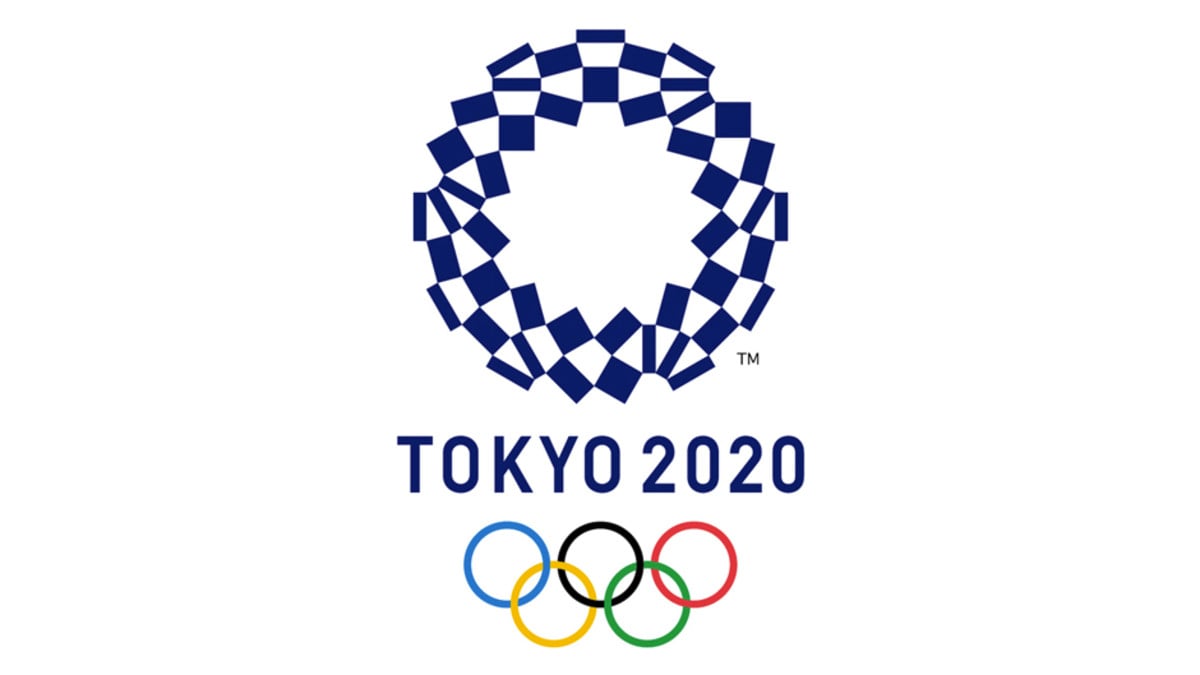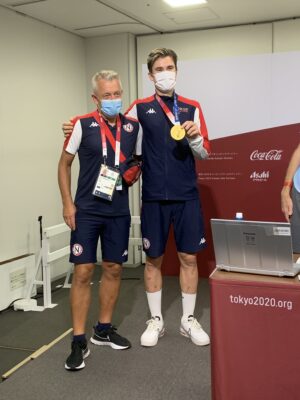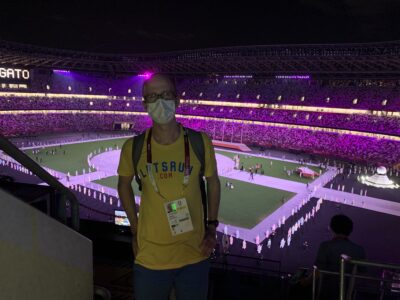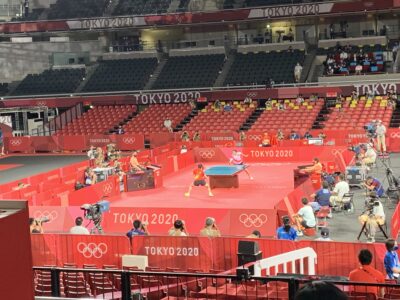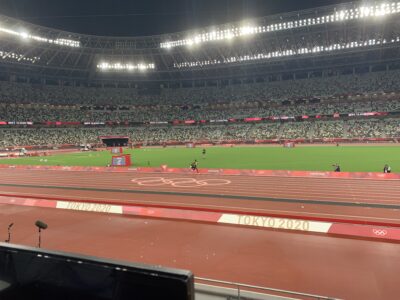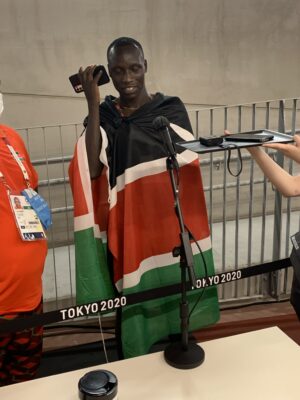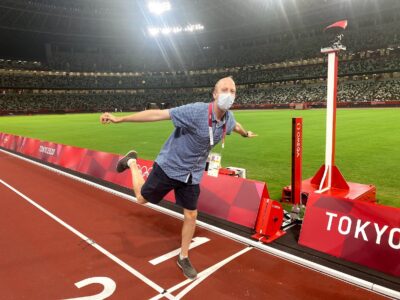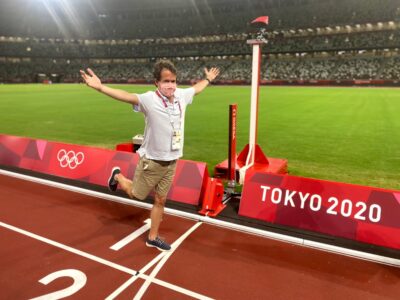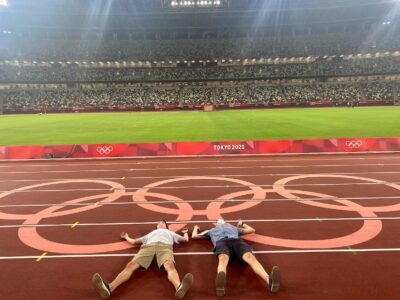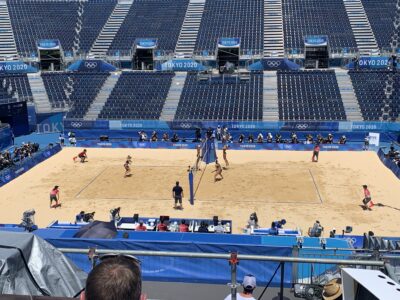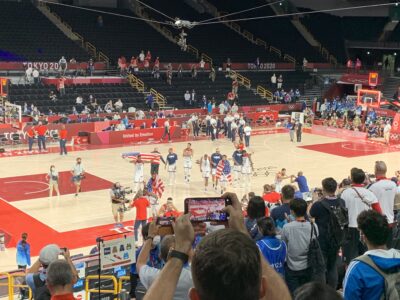7 Final Thoughts From Tokyo: Analyzing Team USA’s Performance, Who Benefited Most from the COVID Delay, & More
By Jonathan Gault
August 12, 2021
TOKYO — The 2020 Olympics are over. And while the track season is far from done — we’ve still got some great meets on the calendar, including the Prefontaine Classic and the new mega Diamond League final in Zurich — there is finally a little time to catch one’s breath, as Pre is still nine days away.
As I write this, I’m stuck in Haneda Aiport, since my flight home has been delayed (update: after a 22-hour delay in Tokyo and a six-hour delay in Chicago, I made it home at 3:30 a.m. ET on Wednesday). And I’m not alone in that plight. Mike Tirico, NBC’s face of the Games, was supposed to be on my flight (no word on whether he was on the delayed flight, but I can confirm he had considerably more luggage than me).
With some time to kill, I figured I may as well empty my notebook and try to make sense of the 10 days of Olympic track & field we just devoured. Some final observations from Tokyo, on and off the track:
1) This was not a great Olympics for the US — particularly on the men’s side — but that doesn’t mean it’s time to panic
When I wrote a version of this column five years ago after Rio, I led by praising Team USA for their best Olympic performance since the Soviet-less 1984 Games on home soil in Los Angeles. This year, the Americans were not nearly as good, winning 26 medals compared to 32 in Rio and barely half as many golds (seven versus 13). Here is how Team USA’s medal count stacks up against past Olympics and the 2019 World Championships:
| Year | Gold | Silver | Bronze | Total medals | Points |
| 2021 | 7 | 12 | 7 | 26 | 52 |
| 2019 | 14 | 11 | 4 | 29 | 68 |
| 2016 | 13 | 10 | 9 | 32 | 68 |
| 2012 | 9 | 12 | 7 | 28 | 58 |
| 2008 | 7 | 9 | 7 | 23 | 46 |
| 2004 | 9 | 11 | 5 | 25 | 54 |
| 2000 | 7 | 4 | 5 | 16 | 34 |
| 1996 | 13 | 5 | 5 | 23 | 54 |
| 1992 | 12 | 8 | 10 | 30 | 62 |
| 1988 | 13 | 7 | 6 | 26 | 59 |
| 1984 | 16 | 15 | 9 | 40 | 87 |
| Average | 10.9 | 9.5 | 6.7 | 27.1 | 58.4 |
*Points = (gold x3) + (silver x2) + bronze
There are undeniably some areas in which Team USA underperformed. Entering the Olympics, it was feasible for the US to win all seven men’s sprinting events (100, 200, 400, 110 hurdles, 400 hurdles, 4×100, 4×400). To come away with just one gold in those events — in the 4×400, an event the US should never lose — is a major disappointment.
But let’s put this performance in context. The US still totally dominated the medal table in Tokyo, winning 26 (Kenya was next, with 10). In fact, the US not only won more golds than any other country (seven versus Italy’s five), but more silvers (12 versus Kenya’s four) and bronzes (seven versus Jamaica’s four) as well. Looking at the table above, this was the USA’s worst Olympic performance since 2008…but it wasn’t far off the US’s average medal or points haul. It just wasn’t as good as the incredible performances at the 2016 Olympics or 2019 Worlds.
Since 1984, Team USA on average wins 27.1 medals with 10.9 of those being gold, 9.5 silver and 6.7 bronze. In Tokyo, the US won 26 medals — so just one fewer medal than normal (okay, two if you consider the mixed gender 4×400 was only added in 2019). The only reason this story getting a lot of attention is there were four fewer golds than normal.
Yes, America has a population advantage over many of its rivals, but track & field is one of the hardest sports to dominate as it is really a bunch of different sports thrown together and the barrier to entry is low. Forty-three different countries won a track & field medal in Tokyo, and 23 different countries won gold (for swimming those numbers are just 21 and 12). Aside from soccer, there is no more global sport than track & field. The US isn’t competitive in every event, but it is competitive in most of them, winning multiple medals in each of the major event groups — sprints, distance, jumps, and throws (everything but the race walk).
2) Taking a closer look at the American men’s lack of gold medals on the track
One of the biggest stories of the 2020 Olympics was the failure of the American men to win a single gold medal in an individual running event — something that had never happened in the 126-year history of the Olympics (outside of the 1980 Games in Moscow, which the US boycotted). This was viewed as a failure by Team USA, but “Team USA” is an illusion. Trayvon Bromell and Grant Holloway don’t train together. One’s success or failure has nothing to do with the other’s. They’re only “teammates” at one of these major championships, when USATF slaps a red, white, and blue Nike uniform on their chests.
I don’t fault my fellow journalists for trying to find an overarching trend that explains the lack of gold medals — that’s our first instinct as journalists, to hunt for trends and explanations. But the best way to explain the results is to look at each event individually, because track & field is an individual sport.
Men’s 100
The US was heavily favored to win this event. In fact, a 1-2-3 finish wasn’t out of the question as Americans Trayvon Bromell, Ronnie Baker, and Fred Kerley entered Tokyo with the #1, #3, and #4 times in the world this year. So to come away with only a silver, collectively, is a disappointment. Bromell was one of the biggest underperformers of the Games — he just didn’t look right in his prelim or his semi and shockingly did not even make the final after a dominant regular season. Baker is a bit of a mixed bag. He ran a pb of 9.83 in the semis, but considering he assumed the favorite status after Bromell failed to qualify, a fifth-place finish in the final is a disappointment. Kerley, meanwhile, gets an A. He was just third at the US trials and no better than fifth in his two post-Trials European meets. To run 9.84 and take silver in the Olympic final is a massive result.
Men’s 200
There’s nothing to criticize about Kenny Bednarek, who ran a 19.68 pb to take silver, or Erriyon Knighton, who finished 4th in the final as a 17-year-old. It gets tricky with Noah Lyles. Based on Lyles’ previous body of work, bronze is a disappointment. This is a man who has dominated the 200 since 2017, the fourth-fastest man in history and reigning world champion who ran world leaders in 2017, 2018, and 2019 and had lost just one outdoor 200 as a pro entering Tokyo.
But Lyles has also spoken candidly about how the pandemic took a serious toll on his mental health and how the antidepressant medication he prescribed, while improving his mood, would sap his energy. He dealt with all this while training for the 100/200 double at a major championship for the first time — a double that would not materialize in Tokyo after he finished seventh at the US Olympic Trials and failed to make the 100 team. If we grade him solely on 2021 Noah Lyles standards, then a bronze in 19.74 — tying his season’s best — is a fine result.
Men’s 400
This event typified the US men’s struggles on the track. Michael Cherry ran the race of his life, a 44.21 personal best, in the Olympic final to finish fourth, just .02 off a medal. That is a tremendous result. Meanwhile Michael Norman, the biggest American talent in this event since Michael Johnson, was just fifth in 44.31, almost a full second off his personal best.
Norman’s struggles — and it does feel a little strange to use the word “struggle” for a guy who won the US Olympic Trials this year — are hard to understand. In 2019, when he ran 43.45 in April but failed to make the World Championship final, it was clear he was not at 100% due to a hamstring injury. But what is the explanation this year? At 23, Norman should be in his prime. Norman ran a ridiculous 9.86 in the 100 last year and his training partner Rai Benjamin is in the form of his life. Is it still his hamstring? Or something else? Nothing about this makes sense.
Men’s 110 hurdles
As my colleague Robert Johnson pointed out, it would have taken a big performance from Grant Holloway to win the Olympic final as Jamaica’s Hansle Parchment summoned a 13.04 — a time he hadn’t touched in six years — to win the gold. Holloway has actually only run 13.03 or faster four times in his life and just 10.3% of time in his last 39 races dating to the start of 2019.
But Holloway has specialized in big performances this year. He hadn’t lost a race in 2021 before the final and three of the four fastest races of his career came in his last five races before the final in Tokyo: 12.81 and 12.96 at the Olympic Trials and 13.02 in the first round in Tokyo. In the final, Holloway fell apart over the final three hurdles and while his 13.09 was still good enough for silver, it was far from his best. That being said, 13.09 is still faster than the time he ran in 2019 to win Worlds (13.10). Fourth in 13.14 is about right for Devon Allen. Had he run his season’s best (13.10), he would have tied with Ronald Levy for the bronze.
Men’s 400 hurdles
Rai Benjamin was the US’s only medal threat in this race and ran the race of his life, 46.17, for second behind Karsten Warholm. In no way, shape or form can that result — over half a second below the existing world record — be considered an underperformance. Benjamin just had the misfortune to get beaten by one of the greatest performances in the history of the sport.
Men’s 800
The 800 was always going to be a difficult event to win at the Olympics, but Clayton Murphy‘s 1:43.17 win at the Olympic Trials — a world leader at the time — stamped him as a gold-medal contender. There was no shame in Murphy finishing off the podium, but for him to finish last in the final was a disappointment. The other Americans, Bryce Hoppel and Isaiah Jewett, were not considered medal contenders and did not even make the final, though Jewett got a bit of a raw deal after falling in his semi following contact with Nijel Amos (I still haven’t heard a good explanation for why Amos was advanced instead of Jewett.).
Men’s 1500
Considering it took 3:29.05 to medal in Tokyo, there was no reason to expect a US medal in that kind of race. Only one American — Bernard Lagat — has ever run that fast, and he was representing Kenya at the time. Cole Hocker ran magnificently to finish 6th in 3:31.40 as a 20-year-old, and while it was a disappointment for Matthew Centrowitz not to make the final, he was not going to medal in a 3:29 race.
Men’s steeplechase
The rest of the world raised its game in this event at the Olympics. Benard Keter responded wonderfully, with a personal best in the prelims and an 11th-place finish in the final. Mason Ferlic missed the final but was only two seconds off his pb in the prelims. Hillary Bor, who was a fringe medal contender after winning a Diamond League earlier this year, definitely underperformed by failing to make the final.
Men’s 5,000
A bronze medal from Paul Chelimo is a good outcome. Grant Fisher (9th) and Woody Kincaid (14th) were not expected to medal and both seemed beaten-up from the 10k.
Men’s 10,000
Grant Fisher is the only American not named Rupp or Shorter to finish in the top five at the Olympics in this event in the last 50 years. He wasn’t considered a medal threat but came closer than most expected (including his own father). 15th and 16th for Woody Kincaid and Joe Klecker might be slightly lower than expectations, but not by much.
Men’s marathon
Before the race, Galen Rupp‘s coach Mike Smith told me that Rupp had a “very contained” range of outcomes. In other words, he knew Rupp would run a good race, but had no idea whether that race would be good enough to medal. Rupp did indeed run a good race, but not the great race he needed to medal and took eighth. The other Americans, Jake Riley (29th) and Abdi Abdirahman (41st) weren’t medal contenders and did well just to make the US team.
***
After all of that, it seems clear: the US’s biggest stars did not deliver on the biggest stage. (I told you I’m trained to look for trends). Bromell, Norman, Holloway, and Lyles have all produced performances in recent years that would have won them the gold medal in Tokyo. They could not summon that performance in the most important race. Is that a failure? From a binary perspective, yes. But it also tells you just how hard it is to win an Olympic title and should make us appreciate the athletes who did deliver as favorites — Athing Mu, Sydney McLaughlin, Ryan Crouser — all the more.
Moving ahead to a home World Championships in 2022, the US is in a good spot. Bromell, Norman, Holloway, and Lyles are all in their primes (Bromell, who turned 26 last month, is the oldest). And the US gets back two reigning world champions who missed Tokyo in Christian Coleman and Donavan Brazier. Look for track golds — multiple — by the US men in Eugene.
3) Youth movement?
Watching 19-year-old Athing Mu win the 800, 20-year-old Jakob Ingebrigtsen win the 1500, and 21-year-old Sydney McLaughlin win the 400 hurdles, it certainly felt as if there was a youth movement afoot on the track. But was there? It depends on how you look at it.
The average age of men’s gold medalists in running events this year was 25.9, which was fairly typical (the number was 27.7 in 2016, 26.2 in 2012, and 23.1 in 2008). Part of the drop from 2016 was due to new blood such as Ingebrigtsen and 21-year-old Selemon Barega. But another factor was the lack of repeat champions. In 2021, only one male runner repeated as Olympic champion: 36-year-old Eliud Kipchoge in the marathon. In 2016, it happened five times: 27-year-old David Rudisha won the 800, 29-year-old Usain Bolt won the 100/200, and 33-year-old Mo Farah won the 5k/10k.
On the women’s side, the average age of gold medalists in running events was 25.5 in 2021, again a fairly typical number (it was 24.9 in 2016, 26.3 in 2012, and 25.4 in 2008). This year saw four repeat champions in Elaine Thompson-Herah (100/200), Shaunae Miller-Uibo (400), and Faith Kipyegon (1500).
2021 did stand out in that, across both genders, there were as many track gold medalists age 21 or younger (four) as in 2012 (two) and 2016 (two) combined. But 2008 (seven) almost had as many as all three of those Olympics combined. Fact is, there is always churn in gold medalists in the Olympics as new stars are born and others fade. In Mu, Ingebrigtsen, and McLaughlin, the sport looks to have three new superstars to carry it through the 2020s.
4) Which events were affected most by the COVID postponement?
After the Tokyo Olympics were pushed back a year, everyone agreed the podiums would look different. With the benefit of hindsight, here are the events that were most shaken up by the COVID-enforced postponement.
Men’s 100
A year ago, Marcell Jacobs was an unknown 10.03 guy and Fred Kerley was a 400 runner. They wound up going 1-2 in the Olympics. Of course, Jacobs was still an unknown 10.03 guy this year as well until two weeks ago.
Women’s 200
Elaine Thompson-Herah was very good in 2020 (she won nine of her 10 races) but hadn’t showed anything suggesting her 2021 form. But the biggest changes come in the silver and bronze positions. Last year, Christine Mboma was 17 years old and had yet to emerge and Gabby Thomas had yet to make the breakthrough we saw this summer.
Men’s 1500
When I asked Jakob Ingebrigtsenwhy he was able to beat Timothy Cheruiyot for the first time in Tokyo after 12 consecutive defeats, he answered politely and rationally.
“I mean, I believe my first attempt, I was probably 15,” Ingebrigtsen said. “Of course he’s been one of the world’s best runners for many years already. I’ve slowly been improving, all the way up to this point.”
Ingebrigtsen was actually 16 when he ran 3:39.92 to finish 10th at the BAUHAUS-galan in Stockholm on June 18, 2017, over nine seconds behind Cheruiyot, who won the race in 3:30.77. By his next matchup at the Prefontaine Classic a year later, Ingebrigtsen had chopped that gap to less than three seconds. But by 2020, Ingebrigtsen had not quite beaten Cheruiyot yet, but he was closer still, finishing second behind him in Monaco and Stockholm. One extra year may have been just what Ingebrigtsen, 20, needed to topple his rival in Tokyo.
Women’s 800
Athing Mu and Keely Hodgkinson went from 2:01 personal bests as 18-year-olds to 1:55 and a 1-2 finish in the Olympic final as 19-year-olds. Pretty significant jumps.
5) The men’s 400 hurdles was the best event — in any sport — in Tokyo
It seemed impossible for the men’s 400 hurdles to exceed the pre-event hype generated by the performances of Karsten Warholm and Rai Benjamin this season. Even if both men ran under the existing world record, 46.70 by Warholm, not many track nuts would have been surprised.
But no amount of hype could have prepared us for the mayhem that unfolded on the Olympic Stadium track on the morning of August 3. Watching Warholm and Benjamin duel down the home straight was incredible, and when I saw the clock stop at 45.94, I could not help but scream. I just kept repeating the same two digits.
45! 45! He ran 45!
Downstairs in the mixed zone, the reaction was unlike anything I had ever seen. I’ve covered three World Championships and two Olympics and have seen my share of world records. Nothing compared to this. No one knew what to say. Was it the spikes? Was it the track? Was the clock broken? How the hell do you take .76 of a second off a sprint record in the year 2021?
Please don’t think that all we wanted to do in the mixed zone was to cheapen Warholm’s performance and the incredible times that followed him. Everyone was in awe of what we — we lucky few allowed inside the stadium that day — had just witnessed. I asked multiple journalists whether it was the greatest race they had ever seen in person. A unanimous yes. The only question was whether it was the greatest race ever. That’s impossible to answer, but the fact that it was even in the conversation was proof of just how special that final was.
6) From inside the Olympic bubble, you couldn’t tell anyone in Japan was opposed to hosting the Olympics
![]() In the leadup to the Games, you probably saw a number of widely-publicized polls about the Japanese public’s support (or lack thereof) for hosting the Olympics. One survey conducted by the Asahi Shimbun newspaper in May found 43% of respondents wanting the Games to be cancelled and just 14% for them to go ahead (40% wanted them postponed again, which was never an option). An online petition titled “Cancel the Tokyo Olympics to protect our lives” garnered over 450,000 signatures. Plenty of Japanese citizens did not want these Olympics to happen.
In the leadup to the Games, you probably saw a number of widely-publicized polls about the Japanese public’s support (or lack thereof) for hosting the Olympics. One survey conducted by the Asahi Shimbun newspaper in May found 43% of respondents wanting the Games to be cancelled and just 14% for them to go ahead (40% wanted them postponed again, which was never an option). An online petition titled “Cancel the Tokyo Olympics to protect our lives” garnered over 450,000 signatures. Plenty of Japanese citizens did not want these Olympics to happen.
I didn’t see any of them, though. Obviously that’s self-selecting. Of course the volunteers and staff who chose to work the Games wanted them to happen. And of course the fans I saw outside the Olympic Stadium every day, lining up just to get a picture of it through the 10-foot metal fence, were happy the Games were on. But the Olympic Stadium would also have been the perfect place to protest the Olympics, and I didn’t see any demonstrations (that’s not to say they didn’t exist).
One moment that stood out: as I walked to my seat for the Closing Ceremony on Sunday night, I looked out of the stadium to an apartment building across the street. Inside, people had decorated their windows with flags or the words TOKYO 2020 and were waving their phones back and forth, saying hello to everyone as we headed inside to enjoy the spectacle they were only allowed to watch on television. I waved back — everyone around me did. And when we exited the stadium two hours later, those same people were still waving to us.
And about those volunteers and staffers: rock stars, all of them. Everyone radiated energy and positivity, no matter how small or repetitive the task. When I forgot to fill out a form or walked somewhere I wasn’t supposed to go, there was no anger, only a helping hand. If I had a problem, someone was on a radio immediately to get it fixed. I cannot praise them enough.
Oh, and in case you were interested, of the 676,789 COVID screening tests conducted on Olympic participants between July 1 and August 8, just 163 (0.02%) were positive. All the restrictions seemed to work — even if some of them seemed more performative than preventive.
7) A few final final thoughts
No country is more obsessed with one runner than Norway with Jakob Ingebrigtsen. I’ve been interviewed by multiple Norwegian journalists for my thoughts on Jakob this summer and many of the mixed-zone sessions with other 1500 runners featured Norwegians asking for their opinions on Jakob. It kind of makes sense. Think about the hype surrounding Cole Hocker in the running community in the US. Then transport him to a country not known for producing sports stars and give his family their own reality show…Given that we were prevented from eating in restaurants, the majority of my diet in Japan consisted of convenience store food — which isn’t as bad as it sounds. Japanese convenience stores, known as conbini, are everywhere, and they offer more plentiful (and more tasty) options than their American counterparts. This New York Times article does a great job of explaining the appeal. I can confirm that the Family Mart fried chicken is juicy and delicious, the 7-Eleven corn dog is quality, and every single sandwich is served without crust (which triggered some serious childhood nostalgia)…Japanese beer observations: Sapporo was good, Asahi not so much, and 7-Eleven’s house lager was surprisingly drinkable…The robot revolution may be coming sooner than you think. Watch out, Steph Curry…Tokyo has the cleanest streets of any major city I have visited. It also has the fewest trash cans of any major city I have visited. Can someone explain this to me?…Tokyo was incredibly hot and humid. Like, legitimately miserable to be outside during daytime hours. 90 degrees, 80% humidity every day. Even once the sun set, it was sticky. I sweat myself stupid in the mixed zone, so I can only imagine how the athletes felt…I attended the Closing Ceremony on Sunday night and after seeing the hype video, Paris 2024 can’t come soon enough…
Tokyo photo dump
